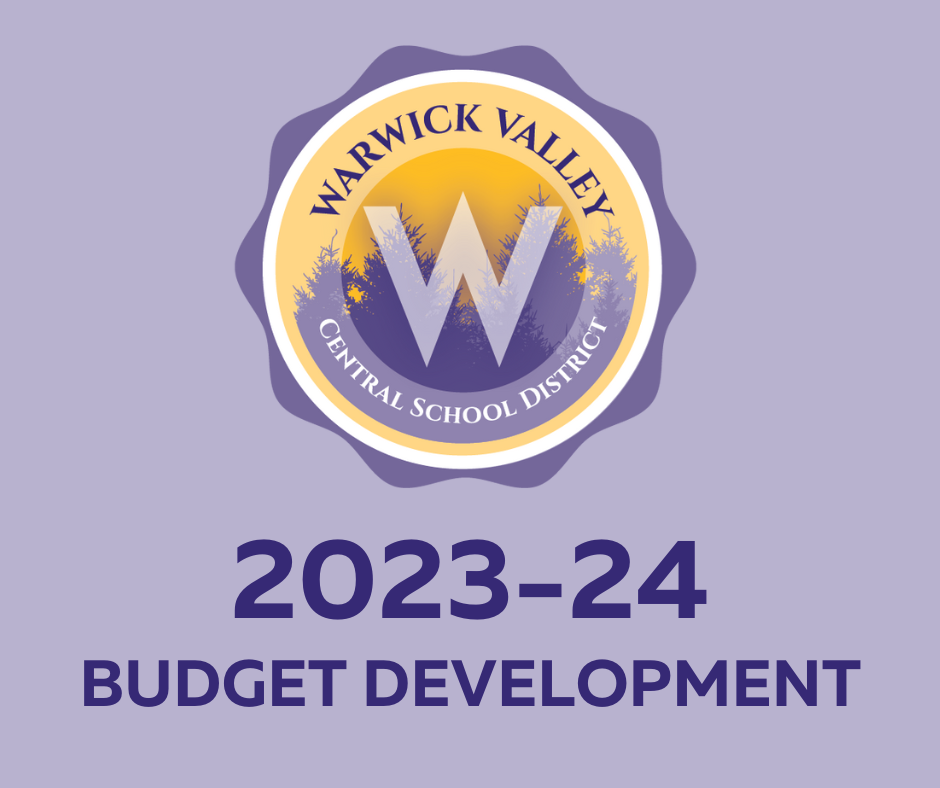2023-24 Budget Presentations Focus on Projected Revenues, Payroll and Benefits as well as Transportation

As part of the budget development process, the budget presentations for the Warwick Valley Central School District for the 2023-24 fiscal year continued on Thursday, February 16, 2023. Projected revenues, payroll and benefits as well as transportation were discussed.
Projected Revenues, Payroll and Benefits
The overarching goals of the budget development process are to preserve academic programs and remain within or below the tax cap threshold. To achieve these goals, the school board has consistently kept the tax levy increases at or below the limit requiring a simple majority vote since 2014, resulting in significant savings for taxpayers. The average annual tax levy percent increase over the last 10 years was 1.62%.
For the year 2023-24, the estimated tax levy increase of $2,877,280 is still subject to change since the Board has yet to set the tax cap. In the past, the Board has been proactive in reducing the allowable tax levy increase, resulting in a total of $1,188,430 in “below tax cap savings” since 2014. In the current fiscal year, the tax levy was reduced by $237,807, in comparison to the previous year.
Dr. David Leach, Superintendent, emphasized that the District conducts a thorough review of the budget to identify areas where reductions can be made without significantly impacting students, and this process would be essential should the Board decide to continue reducing the allowable increase in the tax levy. He also explained that for every 0.25 percentage-point reduction to the proposed tax levy, it would reduce the levy by about $160,837.
Over the last decade, the District has made impressive strides in increasing revenue from non-tax sources. Non-tax revenue has become a significant contributor to the district’s total revenue, with an estimated projection of $4,014,927 in 2022-23 and $4,226,275 in 2023-24. The $211,348 increase can be largely attributed to Day Tuition from other Districts and Total Rental/Use of Buildings, which constitute about 70% of non-tax revenue.
Dr. Leach strongly emphasized the importance of these sources of income, as they have enabled the district to minimize increases in the tax levy for the past nine years. “Non-tax sources of revenue have played a vital role in reducing tax increases, but recent spikes in this area have subsided,” Dr. Leach cautioned. “With buildings now fully rented and the number of non-resident students paying tuition stabilized, the district should not anticipate significant increases in revenue from non-tax sources in the future.”
Despite timely increases in revenue from non-tax sources and New York State Aid during these inflationary times, it’s essential to note that 63% of the district’s revenue still comes from the school tax levy, and the district’s foundation aid is still lower compared to other area school districts due to the state’s wealth ratio calculation. Moreover, the school’s largest budget allocation, representing 72% of the budget, is for personnel costs, including salaries and benefits for staff, as the district continues to prioritize academic student programs, mental health support, responsible class sizes, and learning loss attributed to the pandemic.
Tim Holmes, Assistant Superintendent for Business, presented the District’s reserve fund allocation for the 2022-23 and 2023-24 fiscal years. The reserve funds include Retirement Contribution Reserves for both the Employees Retirement System (ERS) and Teachers Retirement System (TRS), Employees Benefit Accrued Liability Reserve (EBALR), Workers Compensation, Debt Service, and Unemployment.
While the reserve funds have been beneficial in managing the district’s financial stability, the figures show a reduction in revenue for 2023-24 by $200,000 compared to 2022-23, indicating that the district has utilized fewer reserves funds to balance the budget.
Mr. Holmes explained as the district continues to navigate inflationary times, it’s essential to use the reserves cautiously to avoid negatively impacting the district’s long-term financial situation.
Dr. Leach added, “We must prioritize preparing the budget with realistic estimates based on current and accurate information available and resist the temptation to use one-shot revenues to support recurring expenditures.”
Transportation
Laura Chaluisan, Supervisor of Transportation, delivered a detailed report on various aspects of the school district’s transportation department. Her presentation covered a wide range of topics, including the size of the fleet, fuel usage, age, mileage, maintenance, bus routes, and spare buses. In addition, the report highlighted the district’s efforts to optimize New York State aid and reserve funds to aid in the purchase of school buses, providing valuable insights that can help the district make informed decisions about fleet management and improve transportation safety and efficiency.
The district’s fleet comprises 70 buses, including 48 65-passenger buses, five 60-passenger buses, nine 20-30 passenger buses, five wheelchair buses, and three nine-passenger suburban buses. Of these, 31 buses run on diesel fuel, 21 on gasoline and 18 on propane.
The report examined the relationship between vehicle age, average miles driven per year, and the cost per mile of maintaining the vehicle. According to the report, the average miles driven per year for each vehicle is 12,000. The average cost per mile for maintaining a vehicle that is 10 years or older is $3.10, while the cost per mile for vehicles under 10 years is $2.64. This means that the yearly cost of maintaining a vehicle that is 10 years or older is $37,200, compared to $31,680 for a vehicle under 10 years, resulting in a difference of $5,520 in cost.
Dr. Leach emphasized the importance of considering the age, mileage, and condition of a bus when it comes to replacing it. Older buses are more prone to engine failure and become increasingly expensive to repair. Buses with over 125,000 miles may begin to experience internal engine wear that can lead to costly repairs. Additionally, excessive chassis rust can compromise the safety and integrity of the vehicle, and may prevent it from passing DOT inspection.
Maintaining a fleet with older buses, particularly those over 125,000 miles, can be costly and time-consuming. As the mileage of the buses increases, various parts may start to fail or wear out, leading to significant expenses and time spent in the garage. With 43% of the fleet having over 100,000 miles and 23% having over 150,000 miles, the potential costs of maintaining these older buses should be carefully considered. The increased cost and wait time for bus parts may further impact the maintenance and repair process.
The District is considering a proposal to request that voters decide on the purchase of five new buses. The proposal includes plans to purchase five new buses in total, consisting of two 65-passenger Blue Bird propane-powered buses, two 65-passenger International gasoline-powered buses, and one 65-passenger Blue Bird gasoline-powered bus.
Ms. Chaluisan explained that this approach is intended to ensure the orderly replacement of the fleet. With the District currently operating a total of 70 buses, the addition of these new vehicles would help to alleviate the potential costs and safety concerns associated with maintaining an aging fleet.
Mr. Holmes shared the cost of financing school bus purchases in the district during the meeting. The total cost for five vehicles came to $830,000. However, the Bus Reserve contributed $330,000, leaving a net cost of $500,000 to be financed. To alleviate this expense, the district is relying heavily on New York State Transportation Aid, which covers 61.7% of the net cost. Fortunately, this means that there will be no additional cost to taxpayers.
“Bus purchases are indeed an expensive venture,” Mr. Holmes said. “Therefore, receiving 62 cents back on every dollar from the state is crucial.”
Ms. Chaluisan shared some insights to show the importance of the District’s transportation system:
- The district’s fleet traveled a total distance of over 805,037 miles in 2022, the equivalent of circling the world 32 times.
- The fleet was in operation for a total of 35,477 hours, with each vehicle averaging 10,190 miles in distance traveled.
- The longest single trip covered by a bus in the fleet was 230 miles.
These facts demonstrate the significant impact and crucial role the transportation system plays in the district, emphasizing the need for an efficient, sustainable, and well-maintained fleet.

